FeatureUlysse Nardin Freak One: The Rise Of The Freaks
Celebrating the unique individuals whose ideas have revolutionised the world, and the one watch that truly captures their spirit
May We Recommend
It is an irrefutable fact that the world we live in today, the very landscapes of art, music, cinema, technology, finance and even the culinary arts, have all been indelibly shaped by individuals that society once deemed Freaks. Because what else is a Freak but a person with the unique ability to see what others do not? Their sociological deviance finds them in conflict with the status quo, but so powerful and prophetic is their vision that the world cannot hold back their greatness and is ultimately redefined and reshaped in their images. In our history, some of the greatest leaders from Mahatma Gandhi to Martin Luther King Jr, to the great Oglala Lakota holy man Black Elk, have been labelled Freaks. The world’s greatest military leaders from Alexander the Great to Joan of Arc, to Winston Churchill, were once considered Freaks. Painters like Claude Monet were initially rejected by the art world and made the object of scathing derision. Freak One.
Upon viewing Monet’s Impression, Sunrise, critic Louis Leroy fumed, “Wallpaper in its most embryonic state is more laboured than this seascape.” Exactly 150 years later, Monet is revered as an artistic genius for his Freakish refraction of reality through the mimetic language of his brushstrokes. But since the advent of the new millennium, the world has witnessed an unprecedented acceleration and indeed increasing acceptance of Freak Culture. Says Ulysse Nardin’s CEO, Patrick Pruniaux, “It has never been more relevant to be a freak. From musicians like Post Malone or Billie Eilish, to graffiti and tattoo artists, to streetwear designers like Jerry Lorenzo, or the legions of Silicon Valley tech start-up multibillionaires, the individuals that were once outcasts and considered pariah—the freaks—have become the primary success stories of the modern world. Because what is ultimately a freak? It is a person so ahead of their time, so capable of seeing what others cannot, that they threaten the very fabric of normality.”

Pruniaux is right. Each of them has transcended stereotypes and achieved inordinate success by refusing to obey the rules. Accordingly, the symbol for every rule breaker and iconoclast, the ticking horological art form, for every rebel that has defied the imperious hegemony of the status quo and redefined the world we live in today, should be the Ulysse Nardin Freak. Because no other watch has similarly broken every traditional rule of watchmaking and reshaped the art of horology in its own image than this incredible timepiece.
Says Pruniaux, “Today there is no watch that is a greater symbol of the modern freaks’ individualism, their courage to never compromise and the true substance underlying their sense of rebellion, than Ulysse Nardin’s Freak!”
The First Of Its Kind—The Freak Before the 2023 Freak One
Watchmaking history can be divided into two distinct periods: the era before the Freak and the time after it. Launched in 2001, under the behest of the visionary Rolf Schnyder, the Freak was the single most iconoclastic act of horological audacity in the history of modern watchmaking. Here, for the first time, was a movement that performed the act of telling the time. Placed centre stage as the crowning glory of the Freak was an all-new escapement invented by the genius Ludwig Oechslin, a direct impulse, double wheel masterpiece crafted from a material that seemed transported from the world of science fiction—silicon. Now over 20 years later, it is time for the world to be reminded of the incredible everlasting impact of the Freak that ushered in the idea of a timepiece that was also a kinetic sculpture.
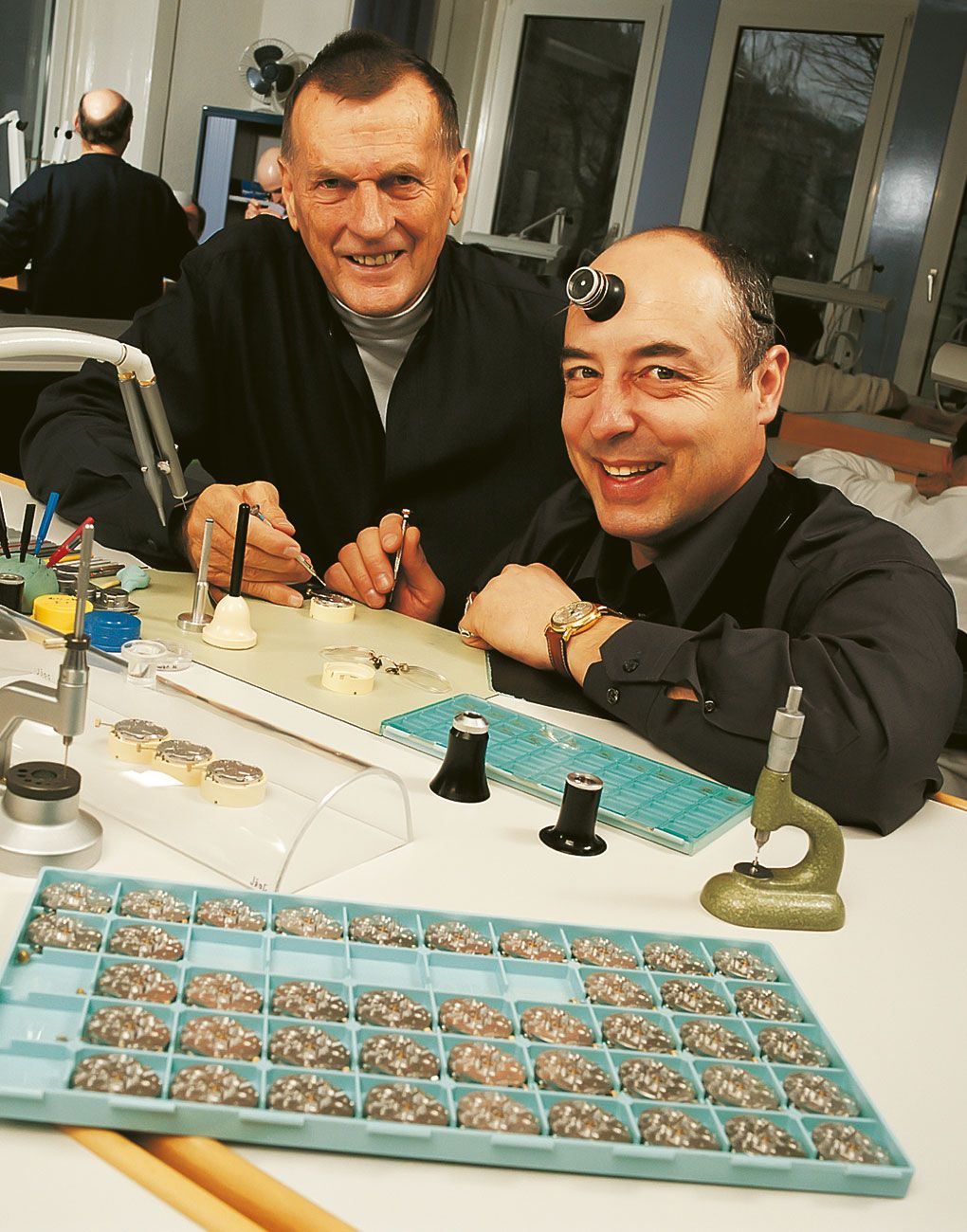
Every key concept that defines new-millennium watchmaking can be traced back to the Freak. The idea of full transparency, being able to see through the watch, comes from the Freak. The concept of the engine as an art form, the movement laid bare in full display as the star, comes from the Freak. The concept of civil time-telling transformed into kinetic art comes from the Freak. Says Michael Tay, owner of Singapore’s legendary retailer The Hour Glass, “Previous to the Freak, watches were about precision and information. Chronographs divided time into fractions of a second. Perpetual calendars charted the shifting rhythms of the date, day, month and leap year. But the Freak introduced something altogether different. To me, it was the first and most significant act of modern horological art. It was a watch whose primary purpose was to convey an emotional or an artistic expression of time.”
The introduction of the Freak at the 2001 Basel fair sent shockwaves through the watch industry. The reception at Ulysse Nardin’s booth was electric. Rumours had spread of a watch that shattered all preconceived notions of traditional haute horlogerie; a watch where the movement was injected with what the ancient Greeks called anima, seeming to come to life to twist and turn to indicate the time, as if a living sentient being.

Says independent watchmaking rockstar Max Büsser, “The Freak opened a door for us all by demonstrating the full expressive potential of mechanical watches. It underscored the true raison d’être for watchmaking today, which is about giving emotion.”
Watch industry legend Jean Claude Biver adds, “The Freak was one of the few brands to show collectors and watchmakers some of the all-new expressive possibilities of the mechanical watch. While I and few other brands were behind the revival of mechanical watchmaking in the ’80s and ’90s, The Freak brought an additional chapter to the story.”
What is so unique about the Freak? It is the first watch ever created where the movement rotates to tell the time. The barrel, like the gas tank of the watch, containing its mighty mainspring rotates once every 12 hours. It is connected to a centre pinion that drives the bridge featuring the gear train around the perimeter of the case flange once every hour. This is the Freak’s famous orbital flying one-hour carousel. Fitted to the end of the bridge is the Freak’s escapement, hairspring and balance. You witness this pulsing with life before your eyes like the beating heart of the watch. Says Pruniaux, “Before the Freak, the oscillator was always at the back of the watch. The Freak was the first watch to put the balance front and centre, almost like a man holding his own beating heart for the world to see.”
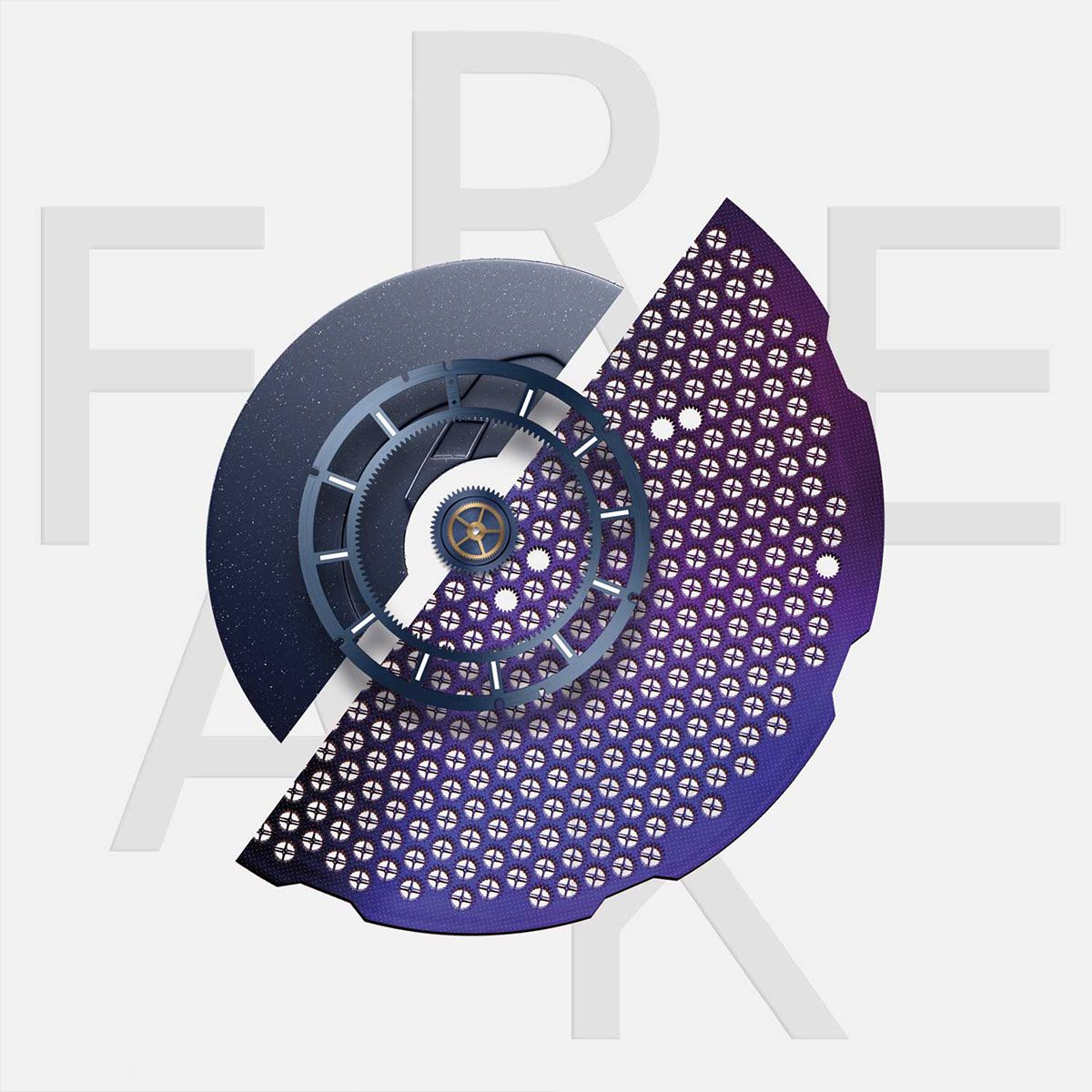
It was legendary Singapore retailer Dr Henry Tay, founder of The Hour Glass and father of Michael Tay, that inspired the disruptive sobriquet for the watch. Said Rolf Schnyder, “He looked at an early prototype and immediately understood that this was like nothing ever before.” It had the visual dynamism of an artwork by Jean Tinguely, a mobile sculpture that gave time, and one that featured the first new escapement in modern watchmaking since George Daniels and the co-axial. Tay said, “This watch is a freak,” and Schnyder stopped and replied, “That’s it. That will be the name of our watch.” And with that, the revolution was ignited.
Silicon: A Technician Revolution
Look closely at the Freak’s heart and you will see that the balance wheel, hairspring and escapement are crafted from silicon. This space-age material is a hard blue grey crystalline solid that has revolutionised watchmaking for several reasons. Using a form of photo-electric etching named DRIE (deep reactive ion etching), it is capable of creating the most precise micro-mechanical parts on the planet. Also, silicon parts require no lubrication to run smoothly. Finally, they are not affected by magnetism, which, to this day, is the culprit behind over 90 percent of service issues.
Ulysse Nardin’s Freak holds the pioneer status as the very first luxury watch to use silicon, and it came down to two little wheels roughly the size of pin heads. These were the two wheels comprising the Dual Direct Escapement created by watch genius Dr Ludwig Oechslin. They were, in turn, inspired by the famous Abraham-Louis Breguet’s échappement naturel, an escapement he designed to no longer require lubrication.
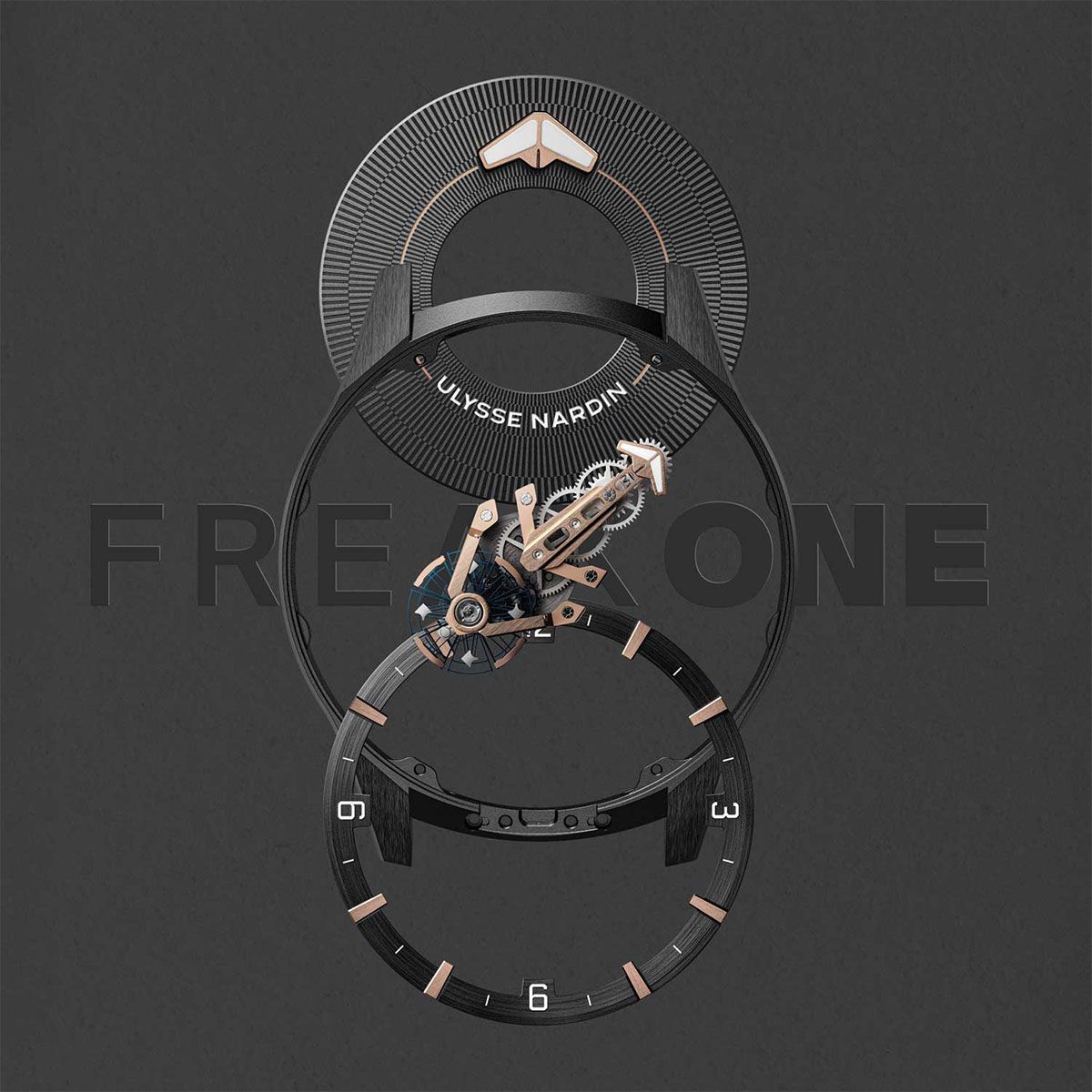
Because the incredible Freak featured its heart beating for the world to see just under its sapphire crystal glass, Schnyder decided that this was the perfect watch to showcase the all-new escapement. But the problem, compared to a traditional Swiss anchor escapement with steel wheels, was that these damn double wheels consumed twice as much energy. Ulysse Nardin had experimented with a variety of other materials such as aluminium. Says Matthieu Haverlan the brand’s chief growth officer, “[Aluminium] wasn’t strong enough and would wear out quickly. The brand famously almost gave up hope when Pierre Gygax (the technical director at the time) proposed the seemingly crazy idea of silicon. He had heard of some experiments conducted by the nearby university, the CSEM, helmed by a scientist named Nico de Rooij.”
Said Rolf Schnyder when I interviewed him many years ago, “I knew that if we had to follow the route of traditional watchmaking, we would never catch up with the entrenched leaders who had already been crafting beautiful complicated watches for centuries. I needed something that would let me leapfrog over the competition and become a leader in the form of new technology. When I saw silicon and understood its true potential in watchmaking, I knew that this was our opportunity.” With that, Schnyder boldly decided to journey where no watch brand had dared go before, with the integration of silicon technology for the two gear wheels of the Freak’s escapement boldly blitzing away for everyone to see right under the sapphire crystal.
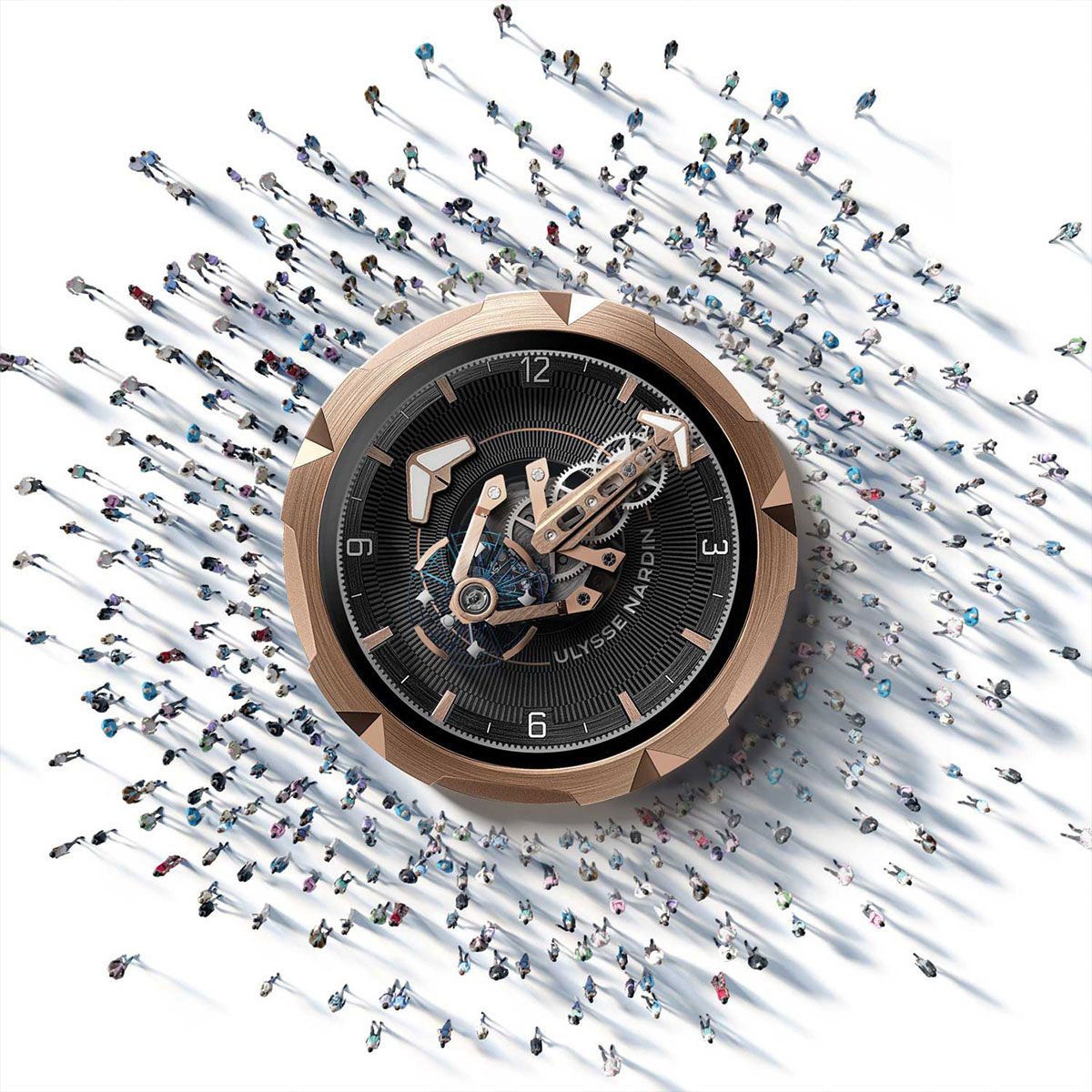
But this news was not without controversy—in particular, related to the madness of replacing traditional steel or brass with a material like silicon. Pundits on internet forums pounded their oak desks in frustration as they decried to the horological gods, “How can such an atrocity be committed?” A few short years later, Patek Philippe’s Philippe Stern would unveil an annual calendar watch, the reference 5250, with a loupe integrated into the watch’s sapphire crystal caseback. He wanted owners to be able to see at full magnification the silicon-based escape wheel within. Said Schnyder, “Stern correctly understood that silicon would revolutionise the watch industry.” Today, the list of brands that use silicon in everything from hairsprings and escapements to much more is innumerable. Indeed, the widespread introduction of silicon has made mechanical watches far more reliable in general. But without the Freak’s extraordinary pioneering status, this would never have come into being.
Often Imitated But Never Equalled
From my perspective, what distinguishes the Freak from every other whirling, twirling, visually dynamic but technically different watch out there is the following: the Freak is an act of watchmaking purity where the rotation you see is given by the movement of the watch itself. That’s right—it is the movement of the watch that rotates at precisely the right speed across two axes that animates the passing of time. To me, this is and will always be a work of unrivalled genius.
So what about all the other seemingly visually complex timepieces out there—those tornados of hyper-speed motion cased inside massive oversized cases? The truth is, all of those watches feature what is, in essence, a relatively simple movement and have additional devices stacked on top of them to create a sense of visual dynamics. Clearly inspired by the Freak, this might even include a balance wheel that travels around the perimeter of the dial. But what you are seeing is a micro-mechanical device that has been intentionally constructed to look as complicated as possible, but from a watchmaking perspective, serves no function and even acts as a parasitical device on the watch’s underlying stability and accuracy.
Now, look at the Freak and what you will see is the purity and horological authenticity of a watch movement that has, through the mind of one of watchmaking’s greatest geniuses, Ludwig Oechslin, been reconfigured to tell the time. We have the watch’s ‘gas tank’ or barrel where the huge mainspring powering everything resides. This occupies the entire bottom level of the Freak. It is precisely configured to make a full rotation every 12 hours and, as such, serves double duty as the watch’s hour indicator. Then, we have the main bridge transmitting the energy of the barrel, across the gear train to the watch’s beating heart known as the oscillator. This bridge is geared to the perimeter of the case, and connected to the barrel, so that as it unwinds, it drives the bridge to complete a full rotation every hour and thus becomes the watch’s minute hand. As power ripples across the Freak’s shimmering gear train, it hits the double-wheel escapement that locks and unlocks each time, sending a small life-giving pulse of energy to the oscillator, compelling it to swing first one way then the other as it divides time into fractions of a second. And therein lies the Freak’s anima energy and heartbeat!
With the Freak, Ulysse Nardin became the very first brand in the world to harness the powerful expressiveness of the time-telling art, but in a way that retains all the brand’s horological credibility. Why? Because the Freak doesn’t add superfluous layers of devices on top of its movement. Instead, it pares away all that is unnecessary, all that is unneeded.
Here it is the movement itself that gives us time. And because of that, the Freak was the first watch to no longer need a dial, or hands, or even a traditional crown. Through the sincerity with which it expresses the passage of time, the Freak resonates with a purposeful simple beauty.
A New Icon: The Freak One
For 2023, Ulysse Nardin unveiled a powerful expression of the very original Freak iconography but updated to feature a wonderful relevance for the modern world—a watch appropriately named the Freak One. It is, in every way, the direct descendent of the original Freak. It is a watch with no hands, no dial and no crown, and where the movement is king! The Freak One draws design codes from the over-two-decades-long history of this extraordinary watch. The notched bezel comes from the 2001 Freak, the open gear train is from the 2013 Freak Cruiser, and the enhanced legibility harks back to the 2018 Freak Vision. Strap on the Freak One and be prepared for the experience of your life. Your eye is immediately drawn to the Freak’s famous orbital, flying one-hour carrousel. Time is set, as with the original Freak, by unlocking and turning the bezel. The caseback can be used to wind the watch, but the Freak One also features Ulysse Nardin’s innovative ‘grinder’ system.
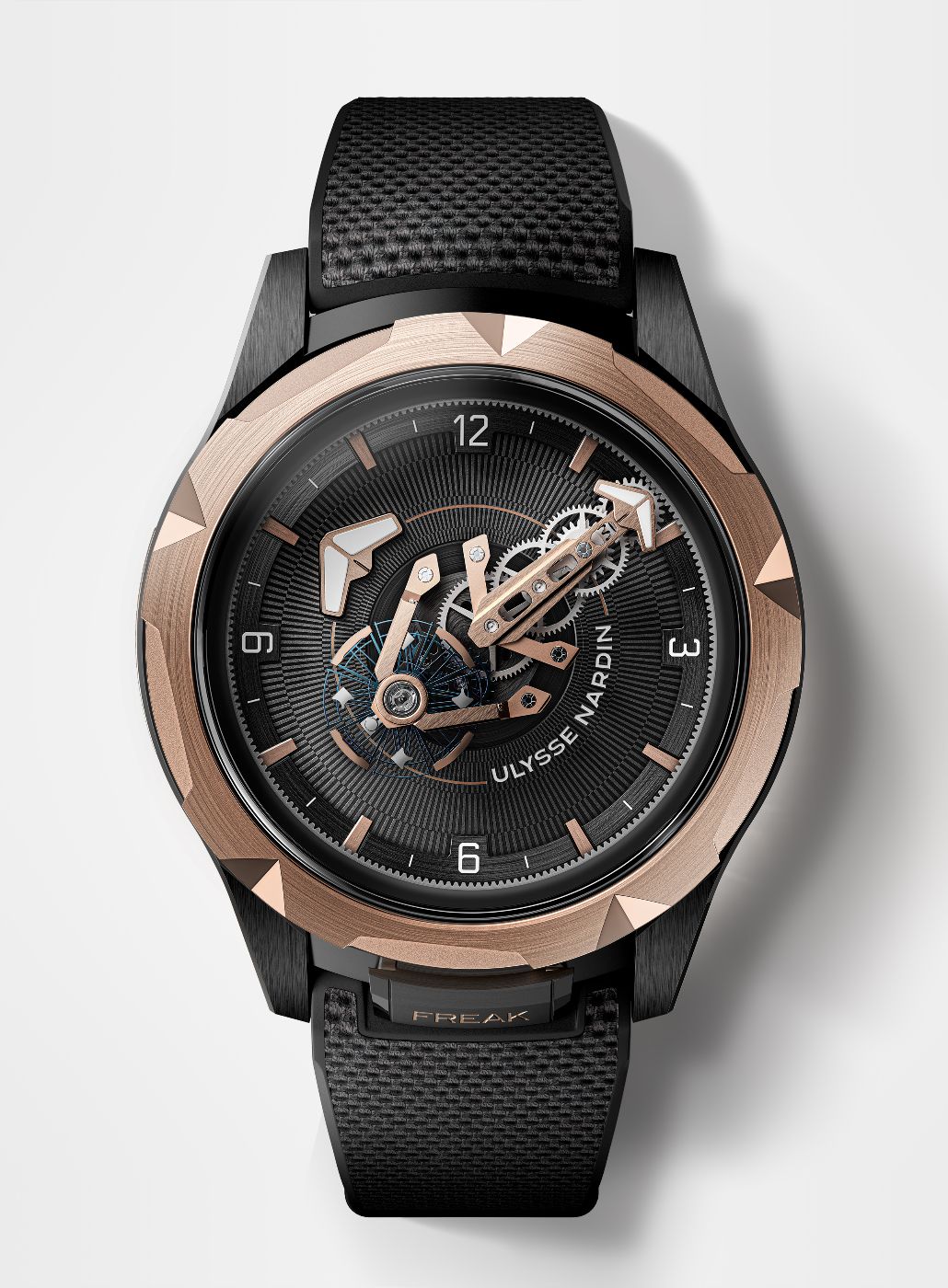
This automatic winding system features four blades connected to the oscillating weight. This design transforms the slightest of wrist motions into energy stored in the mainspring. It is twice as efficient as any other winding system on the market and another demonstration of Ulysse Nardin’s relentless pursuit of making the mechanical watch better.

But the most thrilling element of the new Freak One is the oversized and highly complex, aerodynamic and inertia-optimised balance wheel crafted entirely from one piece of silicon, and a lever escapement executed in DIAMonSIL. This is the result of Ulysse Nardin’s unrivalled expertise in silicon technology and represents the single most advanced oscillator in the watch industry. Indeed, the Freak One represents the very best of the best in all 22 years of the Freak’s history, which has been marked by unprecedented experimentation and technical innovation. The Freak One is offered in black DLC titanium with a rose gold bezel. What is often not mentioned about the Freak is that because of the oversized nature of all its key components, it offers impressive stability and shock resistance. Accordingly, the brand has fitted the watch with a rubber bracelet made of 30 percent plastic waste, so that you can keep it on even during the most rigorous activities.
Says Pruniaux, “I wear my Freak when I’m hiking or skiing. It is a watch that is incredibly resilient and today even more so because of the oversized silicon oscillator.” In other words, it is a watch that can be worn with zero compromise in your life.
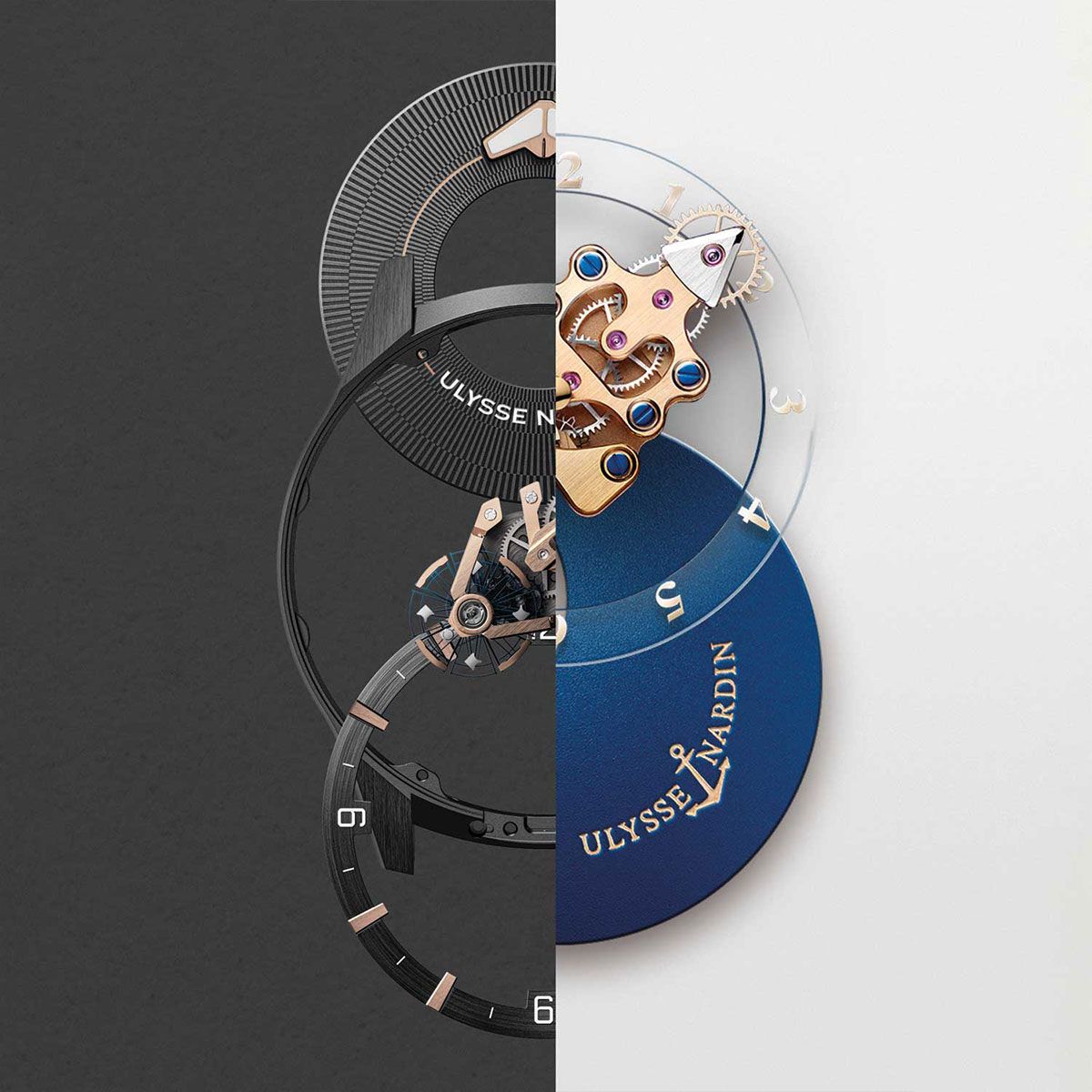
Unleash Your Freak The Ultimate Freakish Tribal Symbol
Today, a watch is no longer a time-telling device but a symbol of self-expression and a tribal identifier. The watch you wear instantly tells the world about your values, your aesthetic philosophy, your mental attitude, and more. With the renewed visual richness and unmistakable iconographic identity of the Freak, Ulysse Nardin is now forming a Tribe of Freak devotees that love the watch for everything it represents in its capacity to elicit emotion.
Strapping on a Freak today expresses to the world that you are effectively ‘unleashing your inner Freak’, allowing yourself the freedom to embrace your ultimate individuality and be connected to those like you for whom rebellion is not a choice but a moral imperative and a true expression of their core identity. It is the watch for any individual that rejects the status quo, blazes their path to the top and, despite innumerable challenges, aims to succeed with their integrity intact. It is a watch for the Freaks in all of us.
This story was originally published on Revolution, in March 2023. Revolution is one of the leading watch media titles, placing mechanical timepieces front and centre in a luxury-lifestyle format. Revolution is a global brand reaching a global audience, but with a strong knowledge of local markets and great relationships with top collectors and watch groups worldwide.






